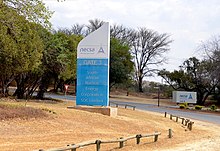South African Nuclear Energy Corporation
 | |
 Pelindaba Nuclear Research Centre (Gate 3) | |
| Industry | Nuclear |
|---|---|
| Founded |
|
| Headquarters | Ellias Motsoaledi Street Extension (Church Street West),Pelindaba, Madibeng Local Municipality,Bojanala Platinum District Municipality,North West Province ,South Africa |
Key people |
|
| Subsidiaries |
|
| Website | necsa |
TheSouth African Nuclear Energy Corporation(Necsa) was established as apublic companyby theRepublic of South AfricaNuclear Energy Act[1]in 1999and is wholly owned by the State.
The name is correctly indicated above, although the sequence of letters in the acronym may be taken as suggesting that the name should be the "Nuclear Energy Corporation of South Africa".[2]
Operations
[edit]Necsa replaced the country's Atomic Energy Corporation.[3]Apart from several ancillary functions, the main functions of Necsa are to undertake and promote research and development in the field ofnuclear energyand related technologies; to process and store nuclear material and other restricted material; and to co-ordinate with other organisations in matters falling within these spheres.[1]Apart from its main operations atPelindaba,Necsa also operates theVaalputsradioactive waste disposalfacility. The corporation also serves the State's other nuclear institutional obligations. The chief executive officer of Necsa is Mr. Loyiso Tyabashe since 1 January 2021.
Necsa has two subsidiaries, which are NTP Radioisotopes SOC is a company that serves the international markets for radiation-based technology and products such as nuclear medicine for diagnosis and treatment of cancer. Pelchem SOC is the second subsidiary which produces fluorochemicals for industrial applications and household.
Necsa employs some 1,700 people in diverse areas such asnuclear physicists,engineering,chemistryandelectronics.With changes in the country's positioning on nuclear involvement and South Africa's re-entry into world markets in 1990, a decision was taken to focus the organisation on commercially driven projects. Today, Necsa supplies a wide range of products and services to South African and foreign market sectors with theSAFARI-1reactor as the cornerstone of the commercialisotopeproduction programme. This research reactor atPelindaba,SAFARI-1produces medical isotopes such asMolybdenum-99which are sold globally by the NTP. The NTP Radioisotopes Group had sales of 1.222 billionZAR(€75M) in 2016.[4][5]
History
[edit]In 1948, the Atomic Energy Board (AEB) was established.[6]In 1957, South Africa and the United States signed an agreement to procure a research reactor. In 1970, the Uranium Enrichment Corporation (UCOR) was established. On 1 July 1982, theNuclear Energy Act (Act 92 of 1982)created the Atomic Energy Corporation (AEC), superseding the former AEB.[6]It became responsible for all nuclear related activities. And on 1 July 1985, the Uranium Enrichment Corporation and Nuclear Development Corporation (NUCOR) was reincorporated into the AEC, having been two separate subsidiary companies created in 1982.[6]The AEC then became the South African Nuclear Energy Corporation in 1999. In 2003, NTP Radioisotopes Group was incorporated as a wholly owned subsidiary of Necsa. In 2007, Pelchem became a wholly owned subsidiary of Necsa.[7]
The 20 MWresearch reactorSAFARI-1was initially used for high levelnuclear physicsresearch programmes and was commissioned on 18 March 1965. In the 1970s and 1980s, amid reduced output due to embargo of international fuel supply, the focus of activities at Pelindaba was on the exploitation of South Africa'suraniumresources through the successful design, construction and commissioning of commercialuranium hexafluoride,uranium enrichment,andnuclear fuelassembly production facilities. In 1993 focus shifted to commercial operations and over the following years typical output increased back to 20MW. Since 2009 the reactor has operated solely onlow enriched uraniumfuel.[8][4]
Mr David Nicholls chairs the Necsa Group board since January 2020 and was reappointed by Minister of Mineral Resources and Energy, Mr Gwede Mantashe in January 2023. The board presence and continuity is accredited for the entity's governance improvement and stability.
In 2021, cabinet approved of a multi-purpose reactor (MPR) which will replace the SAFARI-1.[9]
See also
[edit]- Helikon vortex separation process
- Nuclear fuel cycle
- Nuclear reprocessing
- South Africa and weapons of mass destruction
References
[edit]- ^ab"Nuclear Energy Act, No. 46 of 1999".South African Government.Retrieved27 January2017.
- ^See the'About us'page on Necsa's website. While the correct name is usually used on its website, there is one instance where the incorrect name, "Nuclear Energy Corporation of South Africa", is used on the site. Elsewhere on the web, Necsa's incorrect name is often used.
- ^"South Africa Nuclear Chronology"(PDF).Nuclear Threat Initiative.Retrieved27 January2017.
- ^ab"Annual Report 2016"(PDF).NECSA.Retrieved27 January2017.
- ^"South Africa to resume radioisotope production".World Nuclear News. 19 November 2018.Retrieved20 November2018.
- ^abcSouth Africa 1989-90: official yearbook of the Republic of South Africa.Internet Archive. Pretoria: South African State Dept. of Foreign Affairs. 1989. pp. 566–67.ISBN978-0-7970-1729-0.
{{cite book}}:CS1 maint: others (link) - ^"Necsa Annual Report 2021/22"(PDF).South African Nuclear Corporation.
- ^Iturralde, Mario P. (December 1996). "Molybdenum-99 production in South Africa".European Journal of Nuclear Medicine.23(12): 1681–1687.doi:10.1007/BF01249633.
- ^"CABINET APPROVAL OF MULTIPURPOSE REACTOR ENSURES SOUTH AFRICA RETAINS ITS NUCLEAR TECHNOLOGY GLOBAL FOOTPRINT".Necsa.27 September 2021.Retrieved22 March2023.
External links
[edit]- South African Nuclear Energy Corporation (NECSA) Web site
- Nuclear Liabilities Management,a division of NECSA tasked withNuclear Wastemanagement
- NTP Radioisotopes,a division of NECSA involved in the production and distribution of
Further reading
[edit]- Fig, David(2005). "Uranium Road: Questioning South Africa's Nuclear Direction", Jacana Media.


